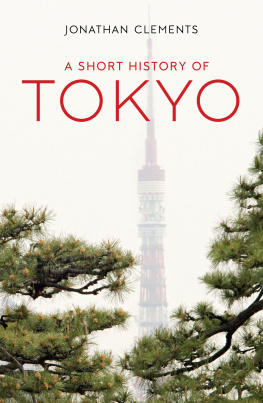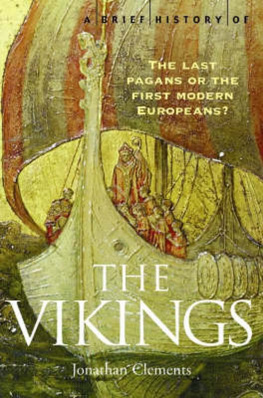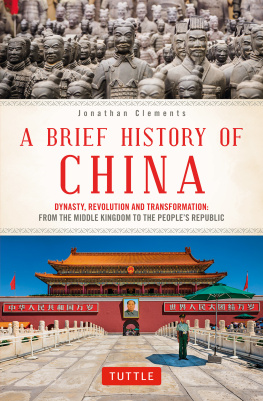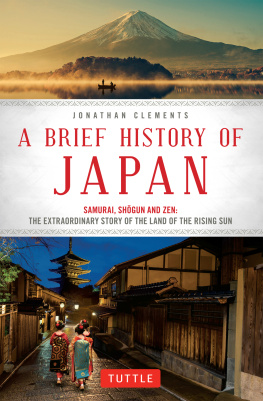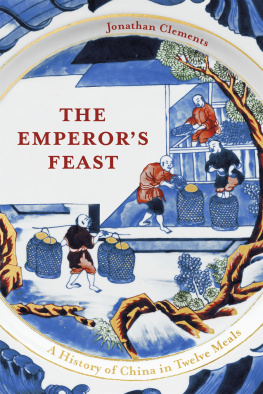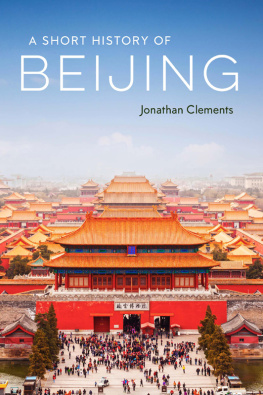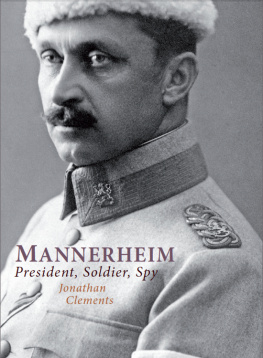Jonathan Clements - A Short History of Tokyo
Here you can read online Jonathan Clements - A Short History of Tokyo full text of the book (entire story) in english for free. Download pdf and epub, get meaning, cover and reviews about this ebook. year: 2020, publisher: Haus Publishing, genre: Non-fiction. Description of the work, (preface) as well as reviews are available. Best literature library LitArk.com created for fans of good reading and offers a wide selection of genres:
Romance novel
Science fiction
Adventure
Detective
Science
History
Home and family
Prose
Art
Politics
Computer
Non-fiction
Religion
Business
Children
Humor
Choose a favorite category and find really read worthwhile books. Enjoy immersion in the world of imagination, feel the emotions of the characters or learn something new for yourself, make an fascinating discovery.
- Book:A Short History of Tokyo
- Author:
- Publisher:Haus Publishing
- Genre:
- Year:2020
- Rating:3 / 5
- Favourites:Add to favourites
- Your mark:
- 60
- 1
- 2
- 3
- 4
- 5
A Short History of Tokyo: summary, description and annotation
We offer to read an annotation, description, summary or preface (depends on what the author of the book "A Short History of Tokyo" wrote himself). If you haven't found the necessary information about the book — write in the comments, we will try to find it.
A Short History of Tokyo — read online for free the complete book (whole text) full work
Below is the text of the book, divided by pages. System saving the place of the last page read, allows you to conveniently read the book "A Short History of Tokyo" online for free, without having to search again every time where you left off. Put a bookmark, and you can go to the page where you finished reading at any time.
Font size:
Interval:
Bookmark:


JONATHAN CLEMENTS is the author of many books about Japan, including A Brief History of the Samurai, Anime: A History, biographies of Admiral Tg and Prince Saionji, and The Dorama Encyclopedia: A Guide to Japanese TV Drama Since 1953 (with Tamamuro Motoko). He wrote the Asia and the World chapters for the Oxford University Press Big Idea history series for schools, which won an Australian Publishing Association award for Excellence in Educational Publishing in 2012. His recent books include Christs Samurai: The True Story of the Shimabara Rebellion and A Brief History of the Martial Arts. Since 2016, he has presented Route Awakening, a National Geographic TV series about icons of Chinese history and culture.

For Motoko
First published in Great Britain in 2018 as
An Armchair Travellers History of Tokyo by
The Armchair Traveller
4 Cinnamon Row, London SW11 3TW
This first paperback edition published in 2020 by Haus Publishing Ltd
Copyright 2018 Jonathan Clements
The moral rights of the author have been asserted
A CIP catalogue record of this book is available from the British Library
ISBN: 978-1-912208-97-5
eISBN: 978-1-913368-00-5
Typeset in Garamond by MacGuru Ltd
Printed in the United Kingdom by Clays Ltd (Elcograf S.p.A.)
All rights reserved
E very view was like a picture on a fan, wrote Isabel Anderson of her trip through the Tokyo streets for an audience with the Tashi Emperor.
We went on past the walled residence of ancient feudal lords; past the torii the bird-rest gates at temple entrances through which we caught glimpses of stone lanterns and the wide-open fronts of picturesque shrines. Again, we passed tea-houses from which the twang of samisen was heard; and left behind us rows on rows of shops with wares of every kind exposed in front for trade. Everywhere the men and quaint little women went stumbling along on their clicking clogs, bowing low to one another; and every moment through some opening of wall or entrance we could see delightful little gardens of tree and stone and water arranged in a way both fascinating and fanciful.
The year was 1912. Much of Tokyo was a ramshackle slum of low wooden buildings. Parts lay derelict, deserted by the last of the samurai a generation earlier and left to fall into ruin. Others were shanty towns of vagrants, or workshops belching industrial smog, the streets drowned beneath the din of clanking trams and noisy factories. Anderson, the wife of the newly appointed US ambassador, chose to see a fairy-tale Japan straight out of The Mikado, and in doing so managed to encapsulate much of the countrys orientalist appeal to its foreign visitors.
Many Japanese will tell you, wrote the humourist George Mikes in 1970, that Tokyo is an ugly city. You must not disagree with them because that would be discourteous; you must not agree with them either, because that would be even more discourteous. You say: Beauty is in the eye of the beholder. Mourning much of the urban renewal that had accompanied the 1964 Olympics, Mikes thought the place had already gone to the dogs not that he gave it much of a chance to begin with. London is a galaxy of countless villages, he wrote, but Tokyo is an overgrown small town a dreary conglomeration of houses without a real centre.
Tokyo, the Eastern Capital, has only enjoyed that name and status for the last 150 years. Before then it was Edo (meaning Estuary), a sprawling town by the bay, which was briefly the largest city in the world. Before then, it was the site of Edojuku (meaning Estuary Lodge), a medieval outpost that kept watch over farming estates. Whereas the imperial court ruled Japan from the sleepy city of Kyto in the south, the landowners of the plains beyond the mountains held the true wealth and power, which they eventually asserted in a series of civil wars.
In the seventeenth century, the region became the administrative centre of Japans Shgun overlords and the site of a vibrant, vivid urban culture of theatres, taverns and brothels. After the Meiji Restoration in 1868, it became the true capital, home to the Emperors, seat of government and site of rapid urban growth. Today, Tokyo is home to some 13 million people or, if one wants to include the suburbs, 37.8 million. To put it another way, this book about a single city is obliged to address a contemporary population larger than that of Peru. Nor is it merely a cluster of districts around Tokyo Bay; modern Tokyos reach and infrastructure extends deep into nearby Yokohama, Chiba and Saitama, and, thanks to a quirk of political administration, more than 1,000 kilometres to the south along the Ogasawara island chain, all the way to Iwo Jima.
It can be difficult to separate what is required of a history of Tokyo from a history of Japan in general. Tokyo has been a nexus of power and people for a thousand years, which has made it crucial to historical events in the whole country. Throughout the period of the Tokugawa Shgunate (16001868), for example, the enforced attendance of feudal lords in Edo ensured that the city was a crossroads in customs and styles. Whatever the cool kids were doing in the Shguns city soon made it out into the provinces; whatever new fad had caught on in the provinces was sure to be picked up in Edo by the time that seasons samurai had rotated back to their home towns. By the twentieth century such cultural dominance was fixed even more firmly, as radio and then television broadcasts ensured that the capitals argot, slang and gossip were swiftly transmitted to the periphery.
This can even influence historiography the story of history itself since Tokyo is usually the place where visitors are most likely to make landfall. It is Tokyo, for example, where Edward S. Morse first began documenting the archaeology of ancient Japan but he found it there because he was taking up a post at the Imperial University (now named the University of Tokyo). Later researchers have determined that the earliest extant examples of Jmon pottery are to be found far to the south, but the original discovery was a Tokyo event.
Although all cities see land usages come and go, Tokyo is more susceptible than most to sudden transformations in its appearance. Out in the suburbs, its districts derive their names from farms and roadhouses assimilated by the growing samurai-era sprawl. In 1878, the traveller Isabella Bird wrote in some disappointment to her sister that although she had boarded a train to Tokyo, she was forced to get off at either Shinagawa or Shinbashi, two of the many villages that have grown together into the capital. Tokyo, for her, was difficult to point to, a catchall title for a cluster of districts without a real centre or identity.
The outlines of many of Tokyos wards were defined by sudden crises fires, floods or quakes that left pockets of land ripe for renewal. Sometimes these crises have been political: the overnight departure of the samurai lords, leaving their mansion quarter derelict, or the end of the US Occupation, leaving multiple military bases ready for redevelopment. But few of these events have been met with the necessary remedial funding or long-term oversight. After the great earthquake of 1923, Mayor Got Shinpei hoped to create a new ultra-modern city, but was forced to cut back until only one of his planned thoroughfares survived. The tangle of small landholdings often makes it difficult to requisition a large enough space for something truly different and wide ranging only 5% of Tokyos space is devoted to parkland, compared to 30% in London.
Font size:
Interval:
Bookmark:
Similar books «A Short History of Tokyo»
Look at similar books to A Short History of Tokyo. We have selected literature similar in name and meaning in the hope of providing readers with more options to find new, interesting, not yet read works.
Discussion, reviews of the book A Short History of Tokyo and just readers' own opinions. Leave your comments, write what you think about the work, its meaning or the main characters. Specify what exactly you liked and what you didn't like, and why you think so.

